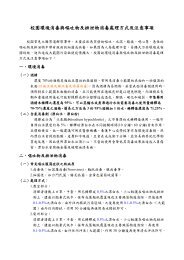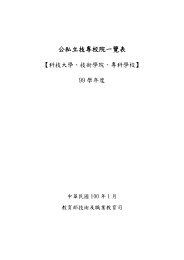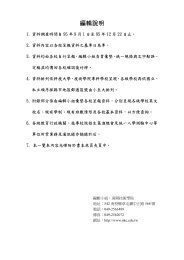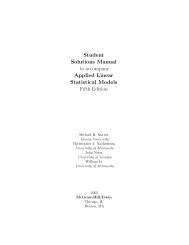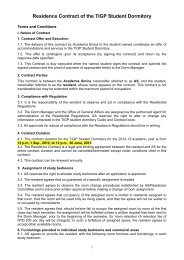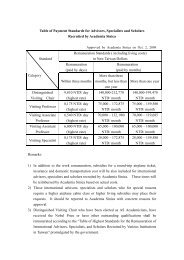Journal of Film Preservation - FIAF
Journal of Film Preservation - FIAF
Journal of Film Preservation - FIAF
You also want an ePaper? Increase the reach of your titles
YUMPU automatically turns print PDFs into web optimized ePapers that Google loves.
Esta entrevista tuvo lugar en el marco<br />
del proyecto « Historia oral de la <strong>FIAF</strong> »<br />
en casa de Eileen Bowser, en Nueva<br />
York, el 27 de julio 2009. El texto fue<br />
revisado y corregido para su publicación<br />
en el JFP. Las modificaciones aportadas<br />
a la transcripción de la entrevista<br />
fueron efectuadas con la ayuda<br />
y la complicidad amistosa de la<br />
entrevistada.<br />
Singular trayectoria la de Eileen Bowser:<br />
nacida en Columbia Station, Ohio,<br />
en una región agrícola, mantiene un<br />
recuerdo lejano pero emocionado<br />
de su niñez, de sus domingos en el<br />
cine con los miembros de su familia,<br />
en la época de la Gran Depresión. En<br />
Columbia Station va a la escuela y<br />
conoce a su futuro marido, Bill Bowser,<br />
con quién más adelante se instalará<br />
definitivamente en el West Village en<br />
Nueva York. En la Universidad de Chapel<br />
Hill, dedicará su diploma al Tintoretto,<br />
y orientará su sensibilidad hacia el<br />
mundo de la imagen. Esta primera<br />
experiencia, le permitirá presentar su<br />
candidatura a varios museos de Nueva<br />
York y, en 1953, obtendrá su primer<br />
empleo en el célebre MoMA, para<br />
ingresar en su Departamento de Cine<br />
en 1955, ser nombrada curadora de cine<br />
adjunta en 1967, y curadora titular en<br />
1976. Eileen pasará a retiro en 1993.<br />
Durante los 50 años de trabajo<br />
en el MoMA, Eileen Bowser fue<br />
testigo y protagonista privilegiada<br />
de la expansión del Museo y de su<br />
Departamento de Cine. Es ahí que<br />
se transforma en la gran especialista<br />
del cine de los primeros tiempos en<br />
los Estados-Unidos y que despliega<br />
su talento de curadora en una época<br />
en que el cine adquiere sus títulos<br />
de nobleza gracias a la política de<br />
selección dinámica de los dirigentes<br />
de la institución, a menudo inspirados<br />
por la sabiduría de Eileen Bowser. Su<br />
trayectoria nacional alcanzó un punto<br />
culminante con la, publicación de su<br />
libro The Transformation <strong>of</strong> Cinema, Vol.<br />
II de la serie History <strong>of</strong> American Cinema,<br />
1990.<br />
Enriquecida por su formidable<br />
experiencia adquirida en el<br />
Departamento de cine, Eileen<br />
reúne las mejores condiciones para<br />
representar al MoMA en los encuentros<br />
internacionales en el preciso momento<br />
en que los intercambios entre<br />
cinematecas <strong>of</strong>recían las mejores<br />
perspectivas para la constitución de<br />
were not. The BFI and the Library <strong>of</strong> Congress were important collectors <strong>of</strong><br />
television material.<br />
But we did finally find ways to collaborate with IFTA/FIAT. We could not<br />
accept the commercial television archives as <strong>FIAF</strong> members. The aims and<br />
principles were very different. The Joint Technical Symposiums were the<br />
solution for the most useful collaboration.<br />
Let’s come back to the contacts you had with colleagues in <strong>FIAF</strong>, in<br />
those times.<br />
There were the pioneers, <strong>of</strong> course. I came in a generation after the<br />
pioneers. Some <strong>of</strong> them were already gone: Iris Barry 30 and John Abbott,<br />
Henri Langlois, Frank Hensel. I was lucky enough, as I said before, to know<br />
Ernest Lindgren, 31 not so many years before he died. I remember that<br />
although we hadn’t been particularly friendly or talked to each other all<br />
that much outside <strong>of</strong> meetings, when he developed a brain tumor and I<br />
think he knew that his death was probably imminent, at his last meeting<br />
he sat down beside me in a bus. I don’t even remember what city or<br />
where we were going, but that was unusual for him, and he sat down and<br />
proceeded to talk to me about Iris Barry, and how important she had been<br />
as his mentor when he was starting out. And I thought at the time he was<br />
saying this to me as representative <strong>of</strong> Iris because I came from MoMA: I was<br />
really very touched by that and I thought that it makes a kind <strong>of</strong> chain if he<br />
was inspired by Iris, because I was inspired by him. I also remember that he<br />
was the authority on the English language for <strong>FIAF</strong> documents. He hated<br />
any American spellings or usage to get into the records. And once he died,<br />
guess who became the authority on the English language? Me! I had to say<br />
what was the correct way. Of course it switched over quite a bit to American<br />
usage and American spelling.<br />
In which way was Iris Barry his mentor? And when did she move to<br />
Europe?<br />
I think in imbuing him with the enthusiasm and the possibilities… She<br />
was a very important person in the EC when he first came to <strong>FIAF</strong>. He was<br />
not the first one to represent the London archive; it was Olwen Vaughn,<br />
I think. And so, he came as a young man to this little group <strong>of</strong> archivists<br />
<strong>of</strong> <strong>FIAF</strong>. Henri Langlois has also said that he regarded Iris as a mentor at<br />
that time. And then after she retired she was still our representative in<br />
<strong>FIAF</strong>. She retired to live in the South <strong>of</strong> France, and I think she remained<br />
our representative chiefly because Richard Griffith hated to travel; he was<br />
afraid <strong>of</strong> flying. He resisted going to <strong>FIAF</strong>. She was paid a small sum by<br />
MoMA to be our European representative, and then she would report back.<br />
It was <strong>of</strong> course not a good system, because we did not have a first-hand<br />
knowledge <strong>of</strong> what was going on in the world <strong>of</strong> archives. It was a mistake<br />
to not actually be there meeting the people and making contacts. Anyway,<br />
that lasted a few years. Richard went to some meetings, but not all <strong>of</strong> them.<br />
He was never very active in <strong>FIAF</strong>. So while Iris was in Europe she was still<br />
attending the EC meetings and the Congress, up to point when she died or<br />
became incapacitated.<br />
30 Iris Barry (1895-1968) was Curator <strong>of</strong> the <strong>Film</strong> Department at MoMA, <strong>FIAF</strong> Secretary<br />
General in 1948, and Founder President from 1949 till 1968.<br />
31 Ernest Lindgren (1910-1973) was Head <strong>of</strong> the National <strong>Film</strong> Archive, London, and<br />
served in several capacities as <strong>FIAF</strong> EC Member, most <strong>of</strong> the terms as VP, from 1946 to<br />
1973.<br />
37 <strong>Journal</strong> <strong>of</strong> <strong>Film</strong> <strong>Preservation</strong> / 81 / 2009





